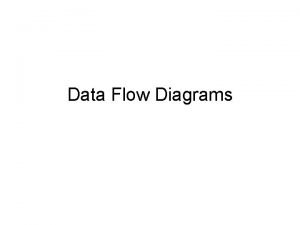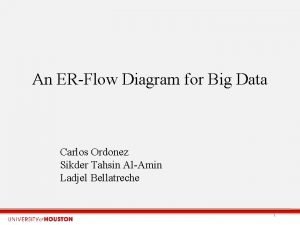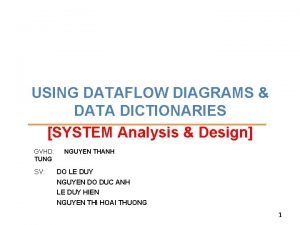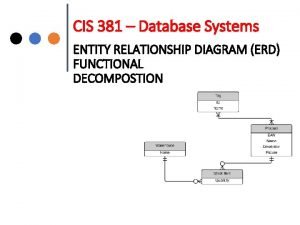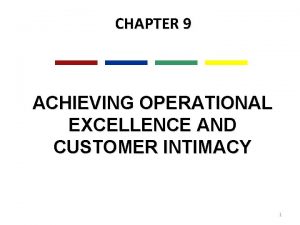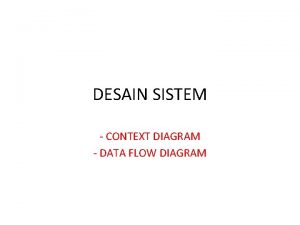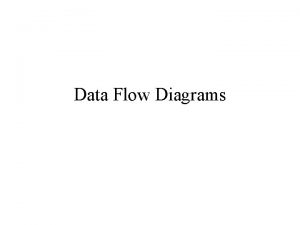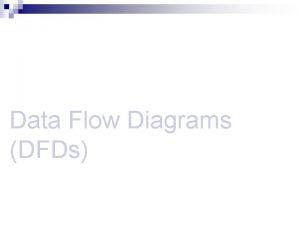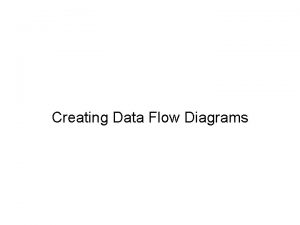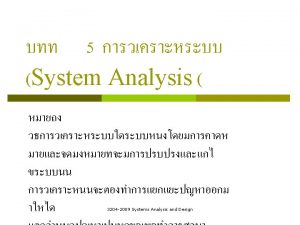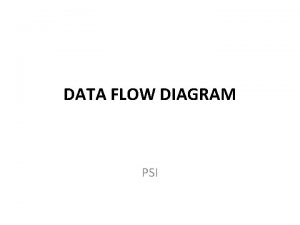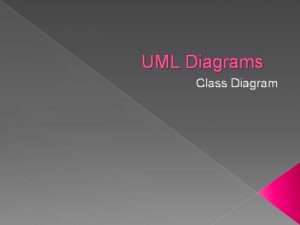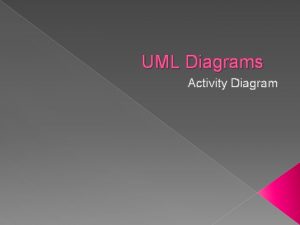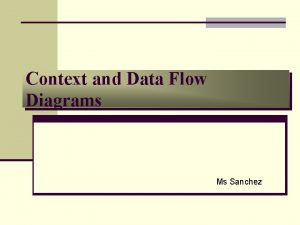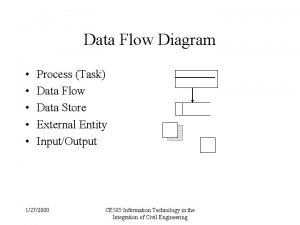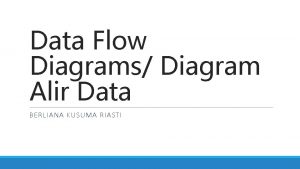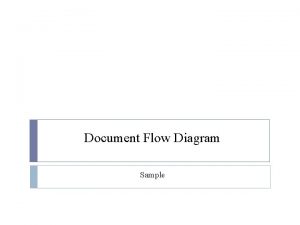Data Flow Diagrams Context Diagram Order Company Customer




















- Slides: 20

Data Flow Diagrams

Context Diagram Order Company Customer Rejected Order Despatch Note + Goods

A Complete DFD Order 1 Sales Check Credit Rating Customer Rejected Order Dispatch Note 2 D 1 3 Warehouse Dispatch Goods Accounts Maintain Credit Ratings Credit Rating

Data Flow Diagrams (DFDs) show: The processes within the system The datastores (files) supporting its operation The information flows within it The system boundary Interactions with external entities

A Data Flow Customer 3 Sales An External Entity A Process Check Credit Rating D 1 Credit Rating A Data Store DFD Symbols

The Process Symbol Unique Number 3 Input Data Where it’s done Sales Check Credit Rating What’s done Output Data

The data store symbol Writing/Updating 3 D 1 Credit Rating Accounts Maintain Credit Rating Reading 1 M = Manual data Store D = Computer File Sales Check Credit Rating

The Data Flow Symbol Use Meaningful names Customer Balance Self Evident Data Flows need not be named 3 D 1 Sales Check Credit Rating

Physical Resource Flow Customer Returned Library Book

The External Entity Symbol Customer A Source and/or sink of data outside the system boundry System Boundary

Levelling – to avoid complex DFDs, processes can be grouped into higher level processes 2 Dispatch Goods Process 2. 1 Validated 1 Order Dispatch Note 2

A Complete DFD Order 1 Sales Check Credit Rating Customer Rejected Order Dispatch Note 2 D 1 3 Warehouse Dispatch Goods Accounts Maintain Credit Ratings Credit Rating

Repeated Symbols – to avoid crossing lines, data stores and external entities can be repeated: Customer D 1 Credit Rating A Duplicated External Entity Duplicated Data Store

DFD Levels Elementary Functional Level 2 Description Get cust dets If order>cred refer Else raise order …. . EFD Level 1

A wines and spirits wholesaler stocks a range of approximately 400 different lines and delivers by van on regular weekly runs to customers who are mainly off-licenses and clubs. The majority of orders are received by telephone and any one customer may place several orders during the week which must be accumulated and delivered in one consignment. When a customer telephones he expects to be advised on the availability of an item requested and, if not in stock, the alternatives that are available. At present, sales order forms are filled in by the telephone salesmen and sent to the warehouse where they are used for the despatch of the items. Hand-written despatch notes are used as the basis of the invoices which are typed and sent by post sometime later. Prepare a dataflow diagram (DFD) which represents the above system.

Developing Dataflow Diagrams 1. Identify external entities 2. Draw context diagram 3. Who/Where does what 4. Identify datastores 5. Draw diagram

External Entities 1. Customer 2. Context Diagram order advice customer des. note + goods invoice company

What Where/who Receive orders Sales Accumulate orders Sales Advise availability Sales Complete Sales Order Form Sales Despatch Items Warehouse Write despatch notes Warehouse Type Invoices Warehouse Send Invoices Warehouse Datastore Stock file

customer Draw DFD Order Advice 1 Sales M 1 Accumulate orders Advise availability Complete forms Sales Order Forms 2 Warehouse Produce despatch notes Produce Invoices Despatch note + goods Invoice customer Stock file

Extensions Maintenance of Stock File Customer file – address, credit etc Payments Accounts dept – invoices, payments etc Accumulate orders – temporary file
 Level 1 data flow diagram
Level 1 data flow diagram Use case model
Use case model Activity diagrams are static diagrams
Activity diagrams are static diagrams Erflow
Erflow Data flow diagram data dictionary
Data flow diagram data dictionary 1st order 2nd order 3rd order neurons
1st order 2nd order 3rd order neurons Supplier er diagram
Supplier er diagram Cheese processing flow chart
Cheese processing flow chart Data flow vs control flow
Data flow vs control flow Control flow and data flow computers
Control flow and data flow computers Efficiency igcse physics
Efficiency igcse physics High context vs low context culture ppt
High context vs low context culture ppt Communicating across generational differences
Communicating across generational differences Constancy under negation examples
Constancy under negation examples Paraverbal adalah
Paraverbal adalah Marketing information and customer insights are
Marketing information and customer insights are Customer relationship management and customer intimacy
Customer relationship management and customer intimacy Perbedaan customer relation dan customer service
Perbedaan customer relation dan customer service Beyond customer satisfaction
Beyond customer satisfaction Customer relationship management and customer intimacy
Customer relationship management and customer intimacy Intimacy
Intimacy
